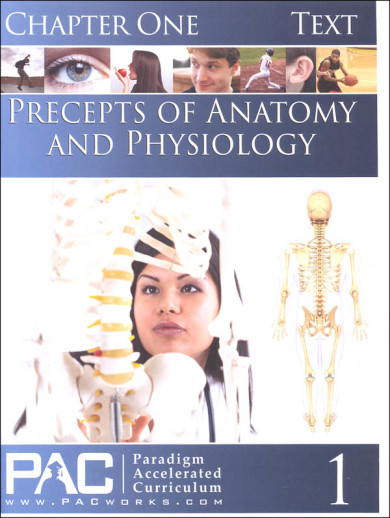We use cookies to make your experience better. To comply with the new e-Privacy directive, we need to ask for your consent to set the cookies. Learn more.
Precepts of Anatomy & Physiology Part 1 Text
Items listed in this section tend to be complete science programs with a teacher and student component, requiring few supplements besides science supplies.
Designed specifically for self-study (although they can also be used in a classroom situation), these courses have a few things in common with Alpha Omega LIFEPACs. First of all, the course is broken down into booklet-sized increments. Secondly, the work is primarily reading and workbook activities. Hands-on "lab" activities are not incorporated into the courses, although you could add them on fairly easily. One major difference, however, is that Paradigm Accelerated courses are not written from a religious standpoint, although they promote good values and are more conservative than most other secular curriculums. One final general note: Paradigm's courses are designed to appeal to all students, even those who may not be interested in science. If your student already loves science and is looking towards a science-related major in college, they may need a more rigorous program.
The courses are made up of text booklets, activity booklets, and a teacher's resource kit. (For some courses, the text portion is available on CD-ROM in .pdf format.) All of the instruction to the student is found in the text. Text booklets each represent a chapter of the course and typically contain three sections, each of which is split into five lessons, or 15 lessons per chapter. Each lesson is between three and four pages in length, and they are usually focused on a specific topic. Definitions of introduced vocabulary used in the lesson and black-and-white illustrations and diagrams further augment each lesson. Lessons always end with a Life Principle, which is usually a thought-provoking quote from a notable individual that relates in some way to the lesson. After the lesson has been read, the student can complete the corresponding activity pages which are typically made up of short-answer, multiple-choice, true/false, and "list" questions that reinforce the lesson. Students are also asked to write the Life Principle for the lesson. There are about 15-25 questions for each lesson which is a fair amount, considering the length of the lesson itself. After five lessons and lesson activities have been completed, there is a review quiz. Quizzes include approximately 50 questions, mostly short answer and multiple-choice. Chapter tests are taken after a whole chapter has been studied and are about 50 questions in length. Quizzes and chapter tests are found in the Teacher's Resource Packet, which also includes complete answer keys and forms for teacher use. Please note that no answers are found in the student materials. Teacher's Resource Kits are available as a CD-ROM with .pdf files or as a loose-leaf paper copy with the CD-ROM. The content is identical between the CD and the paper copy but there may be times when one form or the other is more convenient. (Please note the publisher is transitioning from CD-ROMS to digital downloads.) - Jess
This course can be completed as a stand-alone unit on human anatomy for an estimated ½ credit in anatomy, or combined with Principles, Theories & Precepts of Biology for an estimated two biology credits according to the publisher (requirements vary by state so see yours for specifics). It is a much shorter course than Biology or Physics & Chemistry with only two texts, two activity books, and a teacher's resource kit. The texts cover the history of human anatomy study, levels of body organization, and the major systems of the human body including endocrine, nervous, integumentary, skeletal, muscular, circulatory, respiratory, digestive, excretory, immune, and reproductive. Good health and nutrition are encouraged, and the reproductive system is studied tastefully and conservatively.
| Product Format: | Softcover Book |
|---|---|
| Brand: | Paradigm Accelerated Curriculum |
| Grades: | 9-12 |
| ISBN: | 9781594762543 |
| Length in Inches: | 11 |
| Width in Inches: | 8.4375 |
| Height in Inches: | 0.1875 |
| Weight in Pounds: | 0.35 |

